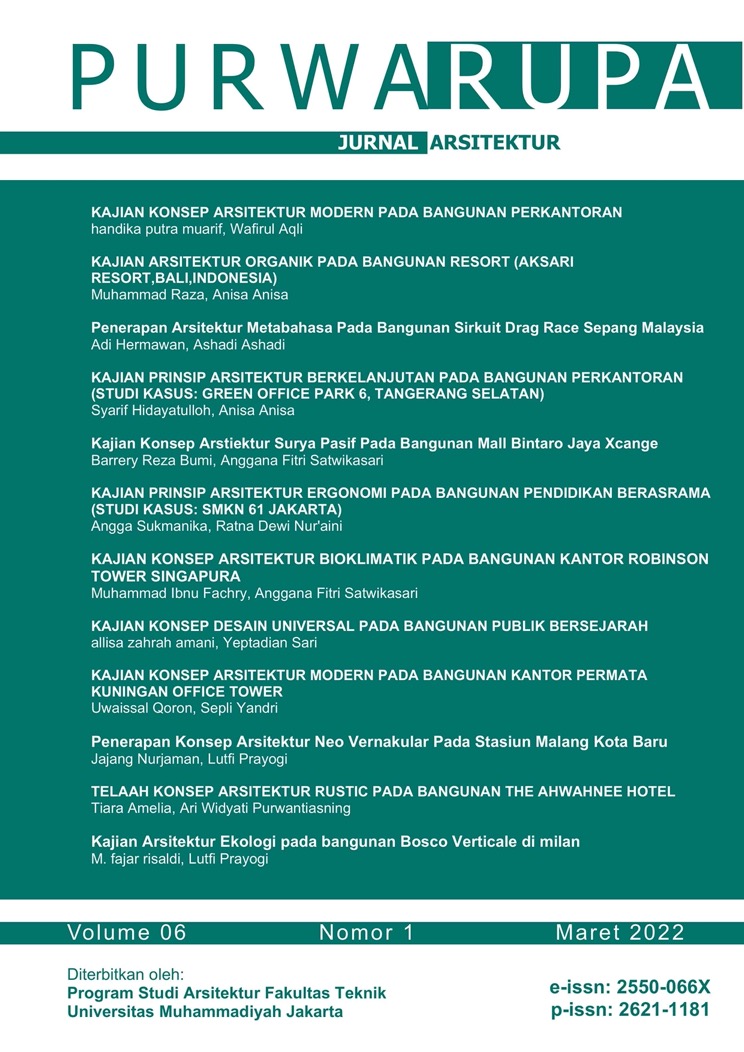KAJIAN KONSEP ARSITEKTUR MODERN PADA BANGUNAN KANTOR PERMATA KUNINGAN OFFICE TOWER
DOI:
https://doi.org/10.24853/purwarupa.6.1.55-62Abstract
ABSTRAK. Kajian ini membahas penerapan konsep arsitektur modern pada bangunan kantor permata kuningan office tower. Hal yang melatarbelakangi pentingnya kajian ini adalah banyaknya perkantoran di Jakarta yang digunakan sebagai fasilitas penunjang perekonomian. Sebuah pengembangan dan penyempurnaan karakter dari sebuah gedung perkantoran juga memerlukan sentuhan konsep arsitektur modern, yang dikira perlu dalam membuat kesan menarik dan modern dalam sebuah bangunan dengan tujuan meningkatkan moral pekerja dan pengguna bangunan. Permasalahan dari penelitian ini adalah bagaimana penerapan prinsip-prinsip arsitektur modern pada bangunan perkantoran Tujuan kajian ini adalah untuk mengidentifikasi dan mendeskripsikan prinsip-prinsip arsitektur modern dan penerapannya pada studi kasus yang diteliti. Obyek penelitian merupakan kantor permata kuningan office tower. Metode penelitian yang digunakan adalah deskriptif kualitatif, dengan menganalisis penerapan prinsip-prinsip arsitektur modern pada studi kasus tersebut. Hasil dari kajian ini adalah perkantoran yang diteliti sudah didesain dengan menerapkan fasade yang membentuk sudut 90°, memeliki bentuk yang sederhana, jendela yang memebentuk sebuah bidang horizontal, penerapan elemen vertikal dan horizontal pada fasad, pemanfaatan roof top untuk área maintenance dan utility, menerapkan bukaan sebagai sirkulasi cahaya dan penghawaan alami, menggunakan warnah cerah, hubungan anatra ruang, elemen utama ruang, efisiensi waktu disebabkan karena hubungan ruang yang baik, struktur yang jujur, pilotis, material yang difabrikasi, penerapan sistema modul, dan bahan dan material sesuai fungsi. Kata Kunci: prinsip, arsitektur modern, perkantoran, fasad, bangunan ABSTRACT. This study discusses the application of modern architectural concepts to the Permata Kuningan office tower. The reason behind the importance of this study is the number of offices in Jakarta that are used as economic support facilities. A development and refinement of the character of an office building also requires a touch of modern architectural concepts, which are considered necessary in creating an attractive and modern impression in a building with the aim of increasing the morale of workers and building users. The problem of this research is how to apply the principles of modern architecture to office buildings. The purpose of this study is to identify and describe the principles of modern architecture and their application to the case studies studied. The object of research is the Permata Kuningan office tower. The research method used is descriptive qualitative, by analyzing the application of modern architectural principles in the case study. The results of this study are the offices studied have been designed by applying a facade that forms an angle of 90°, has a simple shape, windows that form a horizontal plane, the application of vertical and horizontal elements on the facade, the use of roof tops for maintenance and utility areas, applying openings as light circulation and natural ventilation, using bright colors, relationships between spaces, the main elements of space, time efficiency is due to good spatial relations, honest, pilotistic structures, fabricated materials, application of module systems, and materials and materials according to function.Keywords: principle, modern architecture, office, facade, buildingDownloads
Published
How to Cite
Issue
Section
License
COPYRIGHT POLICY
The author(s) of an article published in the Jurnal Teknologi retains ownership of the intellectual property rights in work (s).
PUBLISHING RIGHTS
The author(s) of an article published in the Jurnal Teknologi have unrestricted publication rights. The authors give the Jurnal Teknologi the right to publish the article and designate the Faculty of Engineering Universitas Muhammadiyah Jakarta Publishing as the original publisher of the article.
LICENSING POLICY
Journal of Mechanical Engineering and Sciences is an open-access journal that follows the Creative Commons Non-Commercial 4.0 International License (CC BY-NC 4.0), which states that:

Under this license, the reusers must give appropriate credit, provide a link to the license, and indicate if changes were made. Users may do so in any reasonable manner, but not in any way that suggests the licensor endorses users or their use.
Please take the time to read the whole license agreement (https://creativecommons.org/licenses/by-nc/4.0/). As long as reusers follow the license conditions, the owner cannot withdraw these freedoms. The following components are included under this license:
 Attribution: Users must provide appropriate attribution, including a link to the license, and indicate whether or not they made any modifications. Users are free to do so reasonably, but not in a manner that indicates the licensee approves of their usage.
Attribution: Users must provide appropriate attribution, including a link to the license, and indicate whether or not they made any modifications. Users are free to do so reasonably, but not in a manner that indicates the licensee approves of their usage.
 NonCommercial: Users may not use the material for commercial purposes.
NonCommercial: Users may not use the material for commercial purposes.

